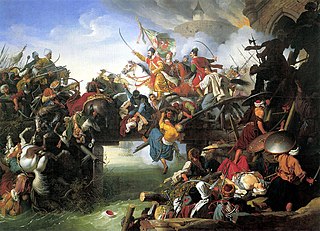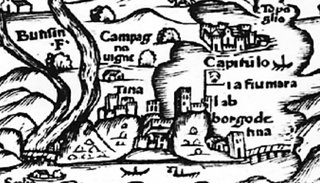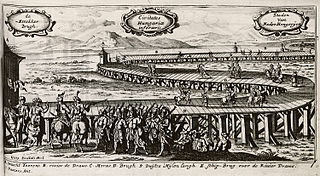See also
- Operation Vrbas '92, a military offensive undertaken by Bosnian Serb army in June–October 1992, during the Bosnian War
Siege of Jajce may refer to:

Stephen Tomašević or Stephen II was the last sovereign from the Bosnian Kotromanić dynasty, reigning as Despot of Serbia briefly in 1459 and as King of Bosnia from 1461 until 1463.

Jajce is a town and municipality located in the Central Bosnia Canton of the Federation of Bosnia and Herzegovina, an entity of Bosnia and Herzegovina. According to the 2013 census, the town has a population of 7,172 inhabitants, with 27,258 inhabitants in the municipality. It is situated in the region of Bosanska Krajina, on the crossroads between Banja Luka, Mrkonjić Grad and Donji Vakuf, on the confluence of the rivers Pliva and Vrbas.

The siege of Szigetvár or the Battle of Szigeth was a siege of the fortress of Szigetvár, Kingdom of Hungary, that blocked Sultan Suleiman's line of advance towards Vienna in 1566. The battle was fought between the defending forces of the Habsburg monarchy under the leadership of Nikola IV Zrinski, former Ban of Croatia, and the invading Ottoman army under the nominal command of Sultan Suleiman the Magnificent.

A series of military conflicts between the Ottoman Empire and various European states took place from the Late Middle Ages up through the early 20th century. The earliest conflicts began during the Byzantine–Ottoman wars, waged in Anatolia in the late 13th century before entering Europe in the mid 14th century with the Bulgarian–Ottoman wars. In the mid 15th century, the Serbian–Ottoman wars and the Albanian-Turkish wars were waged by Serbia and Albania respectively against the Ottoman Turks. Much of this period was characterized by Ottoman expansion into the Balkans. The Ottoman Empire made further inroads into Central Europe in the 15th and 16th centuries, culminating in the peak of Ottoman territorial claims in Europe.

The Battle of Krbava Field was fought between the Ottoman Empire of Bayezid II and an army of the Kingdom of Croatia, at the time in personal union with the Kingdom of Hungary, on 9 September 1493, in the Krbava field, a part of the Lika region in Croatia.

This is the history of Bosnia and Herzegovina in the Middle Ages, between the ancient and Roman period and the Ottoman period.

The Ottoman Empire era of rule in Bosnia and Herzegovina lasted from 1463/1482 to 1878 de facto, and until 1908 de jure.

Doboj Fortress or Gradina (Градина) is located in the city of Doboj, Bosnia and Herzegovina. Throughout its turbulent history, the fortress has been burned and ransacked at least 18 times as per official records. Of note is that Doboj fortress was considered to be a royal Kotromanić property, unlike Great Bosnian Duke Hrvoje's Zvečaj fortress or Sandalj Hranić's Blagaj fortress, which were centers of their respective duchies.

The Ottoman–Habsburg wars were fought from the 16th through the 18th centuries between the Ottoman Empire and the Habsburg monarchy, which was at times supported by the Kingdom of Hungary, Polish–Lithuanian Commonwealth, and Habsburg Spain. The wars were dominated by land campaigns in Hungary, including Transylvania and Vojvodina, Croatia and central Serbia.

The Ottoman–Hungarian Wars were a series of battles between the Ottoman Empire and the medieval Kingdom of Hungary. Following the Byzantine Civil War, the Ottoman capture of Gallipoli, and the decisive Battle of Kosovo, the Ottoman Empire was poised to conquer the entirety of the Balkans and also sought and expressed desire to expand further north into Central Europe beginning with the Hungarian lands.

The Hundred Years' Croatian–Ottoman War is the name for a sequence of conflicts, mostly of relatively low intensity, between the Ottoman Empire and the medieval Kingdom of Croatia, and the later Habsburg Kingdom of Croatia.

The siege of Gvozdansko was an Ottoman siege of the fort of Gvozdansko in the Kingdom of Croatia in 1577–1578. In the 1570s, the Ottomans intensified their efforts to capture the valley of the Una River. A string of forts along the Una, centred around Gvozdansko and in possession of the Zrinski noble family, formed the main line of defense of Croatia since 1527. The fort held off Ottoman attacks in 1540 and 1561.

The siege of Klis or Battle of Klis was a siege of Klis Fortress in the Kingdom of Croatia within Habsburg monarchy. The siege of the fortress, which lasted for more than two decades, and the final battle near Klis in 1537, were fought as a part of the Ottoman–Habsburg wars between the defending Croatian–Habsburg forces under the leadership of Croatian feudal lord Petar Kružić, and the attacking Ottoman army under the leadership of the Ottoman general Murat-beg Tardić.
The siege of Jajce was a siege of the town of and its citadel in 1463, in a push by Ottomans to conquer as much of the Bosnian Kingdom, and continuation of the Ottoman–Hungarian Wars. After the fall of Travnik and royal fortress of Bobovac, in the initial days of invasion, Ottomans, led by Sultan captured the town. One of the parties pursued Bosnian King Stjepan Tomašević, and caught up with him at Ključ fortress, after which he was brought to Jajce and executed. Soon the Ottomans forces withdraw, leaving the town under the protection of a small garrison. The Hungarian took the opportunity to capture the citadel, and this meant that Ottoman advancement in Bosnia was halted for the time being. The norther part of Bosnia were brought under Hungarian control, and divided into three administrative regions, Banate of Jajce, Banate of Srebrenik, and puppet statelet named "Bosnian Kingdom". This situation and Jajce under Hungarian garrison will last until 1527 when the Ottomans finally took the town, and breaking the lines advanced northward to Hungary and westward to Bihać, which was part of medieval Croatia.
During the siege of Naģykanizsa in 1601, a small Ottoman force held the fortress of Naģykanizsa in western Hungary against a much larger coalition army of the Habsburg monarchy, while inflicting heavy losses on its besiegers.
The Battle of Dubica was fought on 16 August 1513 between the Kingdom of Croatia and the Ottoman Empire. The Croatian army was commanded by Petar Berislavić, Ban of Croatia, while the Ottoman army was mostly composed of forces from the Sanjak of Bosnia under command of Sanjak-bey Junuz-aga. The two armies clashed near the town of Dubica in central Croatia, between the Sava and Una rivers. The battle resulted in a Croatian victory and heavy losses for the Ottoman side.

The siege of Knin was a siege of the city of Knin, the capital of the Kingdom of Croatia, by the Ottoman Empire in 1522. After two failed attempts in 1513 and 1514, Ottoman forces led by Ghazi Husrev Bey, sanjak-bey (governor) of the Sanjak of Bosnia, launched a major offensive on southern Croatia in the spring of 1522. In May, his forces, reinforced with troops from the Sanjak of Herzegovina and Constantinople, besieged the Knin Fortress.
The siege of Jajce took place between 10 July and 24 August 1464, during the Ottoman conquest of Bosnia and Herzegovina, when an Ottoman army under Sultan Mehmed II made a new attempt to retrieve Bosnia and conquer the strategic fortress of Jajce, south of Banjaluka. Despite massive bombardment, the final Turkish assault was heavily repulsed and after hearing that King Mathias of Hungary was approaching with a relief army, Mehmed abandoned the siege.

The Battle of Jajce took place in January 1518 during a series of wars between the Ottoman forces of Husrev Beg, Beylerbey of the Bosnia Eyalet, and the Hungarian and Croatian forces led by Croatian Ban Petar Berislavić. The battle was a part of the Croatian–Ottoman wars and Ottoman–Hungarian wars.

Croatian-Slavonian theater in Great Turkish War, concerns military operations undertaken during Great Turkish War 1684-1689 by the forces of Holy League against the Ottoman Empire on territories of Croatia, Slavonia and Dalmatia. The war was concluded by Treaty of Karlowitz in 1699, which significantly eased off the Ottoman grip off Croatia.